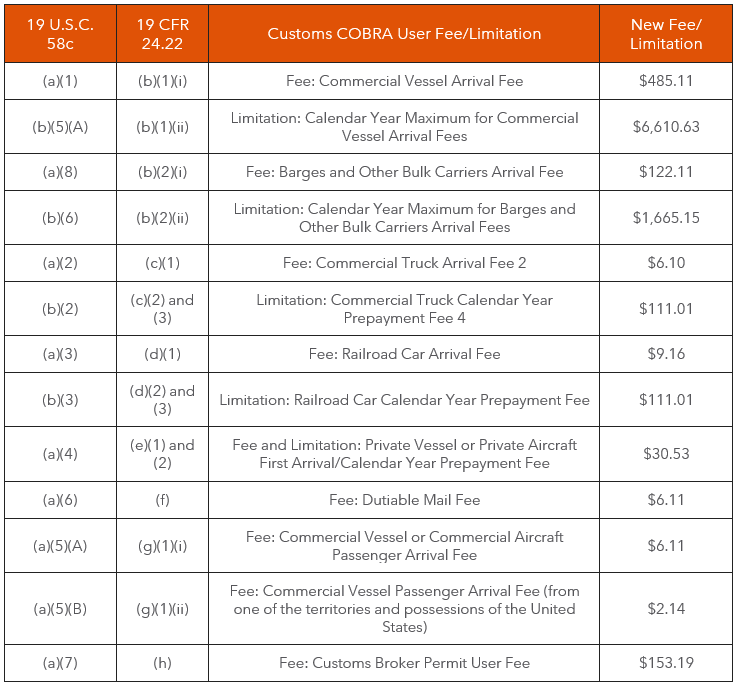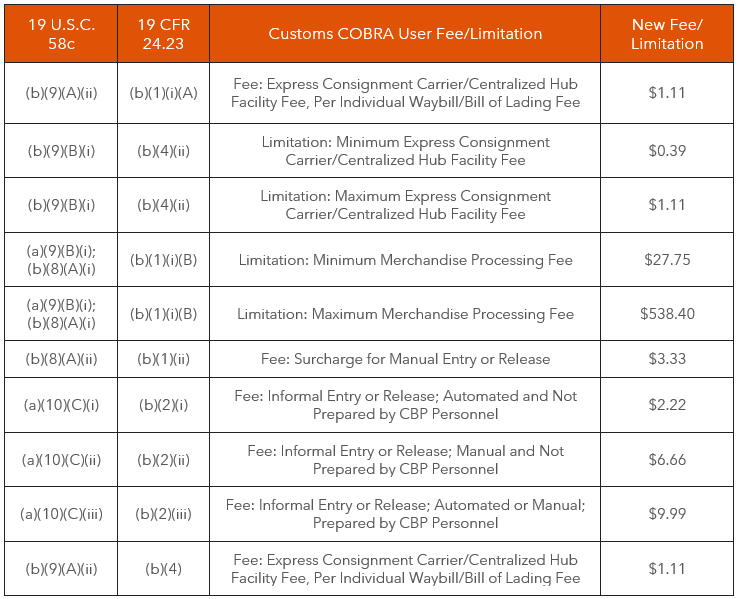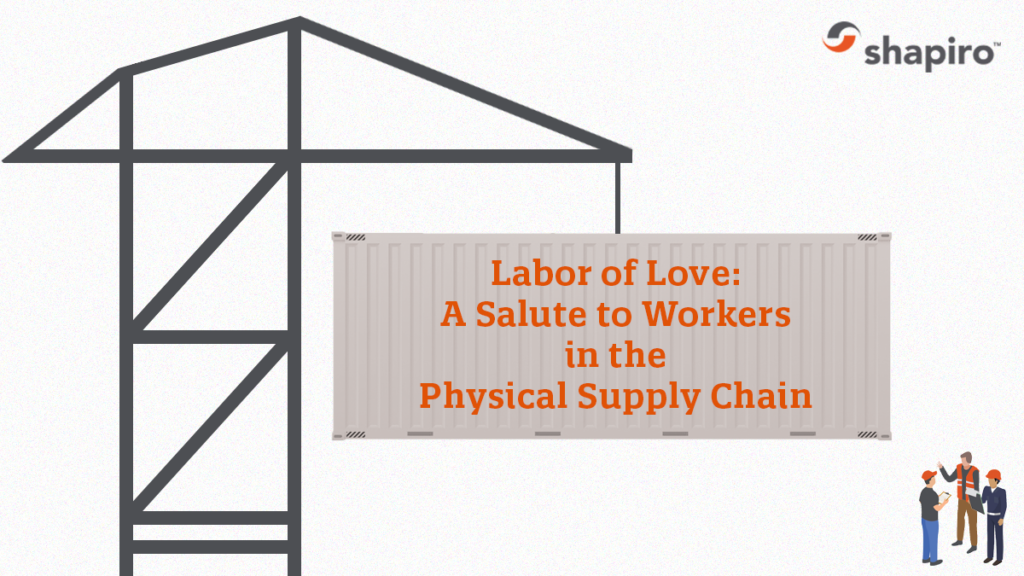Featured Headlines:
CBP Fees Effective October 1, 2021
Everything You Need to Know About the Section 301 Lawsuit Challenging List 3 and 4A Tariffs
Are You Tired of Retransmitting to AES—Don’t Worry, COAC Has Recommendations!
US Goods Returned Under HTS Code 9801.00.10
China—US Sanctions Could Have an Impact on Airfreight Capacity
Vietnam Instituted Stay-at-Home Order Beginning August 23rd
Our Expert Shapinion – Labor of Love: A Salute to Workers in the Physical Supply Chain
CBP Fees Effective October 1, 2021
In the Federal Register Notice dated July 29, 2021, U.S. Customs and Border Protection (CBP) announced fee increases adjusted to reflect inflation effective October 1, 2021. These fees will directly affect your Customs entry.
For instance, the Merchandise Processing Fee (MPF) limitation for formal entries (class code 499) will increase from $27.23 to $27.75 and the maximum limitation will increase from $528.33 to $538.40. The ad valorem rate of 0.3464% will NOT change.
Here a few of the other fees that are changing:
- The fee for informal entry or release (class code 311) will change to $2.22.
- The surcharge for manual entry or release will change to $3.33.
- The dutiable mail fee (class code 496) will change to $6.11.
- The express consignment carrier/centralized hub facility fee will change to $1.11 per individual waybill/bill of lading. Note: An individual air waybill is the bill at the lowest level, and is not a master bill or other consolidated document.
Please reference the tables below or the official Federal Register Notice (pgs. 40864-40866) to gain an understanding of all increases that will commence on October 1, 2021.
TABLE 1 — Customs Cobra User Fees and Limitations Found in 19 CFR 24.22 for Fiscal Year 2022 (adjusted in accordance with the FAST Act)

TABLE 2 —Customs Cobra User Fees and Limitations Found in 19 CFR 24.23 for Fiscal Year 2022 (adjusted in accordance with the FAST Act)

For more information on CBP fees, please reach out to [email protected].
Everything You Need to Know About the Section 301 Lawsuit Challenging List 3 and 4A Tariffs
Per our previous Shap Flash, last month, the Court of International Trade (CIT) announced plans to extend the preliminary injunction preventing the liquidation of unliquidated entries subject to Section 301 List 3 or 4A tariffs from September 2nd until October 4th.
In the same announcement, CIT judges also extended the August 20th deadline for US Customs and Border Protection (CBP) to create a repository for plaintiffs to submit applicable customs entries until September 3rd.
The decision to extend the deadlines for a third time was the result of a joint status report update, originally published on August 9th, that indicated both parties still needed additional time to reach an agreement.
Although the September 3rd deadline had already passed prior to this article’s original publication date, officials had still yet to advise the public on the status of additional extensions, etc.
*UPDATE – Sept. 9, 2021*
We have just learned that neither a repository nor collection and filing of entry data is being required from the court. Please refer to a summary of the order entered on 9/8/2021:
“ORDERED that, in light of Defendants’ representation to the Court that it must accept the option to stipulate to refund any duties found to have been illegally collected for all Subject Entries (as that term is defined in the Preliminary Injunction), Defendants shall liquidate those entries in the ordinary course and, should the Court find that the List 3 and/or List 4A duties have been illegally collected, and should that decision become final and conclusive, including all appeals, Defendants shall reliquidate any Subject Entry in accordance with a final court decision in this case without the assessment of List 3 and List 4A duties or otherwise refund to Plaintiffs such duties, with interest, as provided by law.
This Order shall only apply to entries that were unliquidated at the time of the Preliminary Injunction, and to entries entered on or after July 6, 2021.
ORDERED that the requirement for Defendants to establish a repository, as contained in the fifth ORDERED paragraph of the Preliminary Injunction, is hereby VACATED; and it is further ORDERED that the Temporary Restraining Order issued in the eighth ORDERED paragraph of the Preliminary Injunction, as amended, is hereby VACATED. SEE ORDER.” (Goell, Geoffrey)
For questions related to List 3 and 4A tariffs, please contact [email protected].
Want more up-to-date information sent directly to your inbox? Then sign-up today to receive our Shap Flash alerts for FREE via our Subscription Center!
Are You Tired of Retransmitting to AES—Don’t Worry, COAC Has Recommendations!
If you are a U.S. Principal Party in Interest (USPPI) – or a forwarder on behalf of an USPPI – and file the Electronic Export Information (EEI) using the Automated Export System (AES) in ACE or your own software, you likely feel the pain of trying to obtain the latest information or data elements needed to avoid getting a penalty from U.S. Customs.
Well, the Export Modernization Working Group (EMWG) of the Commercial Customs Operations Advisory Group (COAC) has come out with a White Paper with the intent of laying out a strategy and roadmap for the next phase of the export process. Part of their mission is to demonstrate where data originate, who “owns” that data, who needs it and how it should be used for export enforcement and statistics.
Currently, for example, if you do not continually update the correct date of departure from the rail, truck, steamship line, or airline, your company is open to possible penalties. When a penalty is issued, it is in the amount of $14,362.00. Many of these penalties are mitigated by Customs and Border Protection (CBP), but the cost and time spent to write a petition, for CBP to review the petition, and then actually issue a penalty is quite considerable for all parties.
The Electronic Export Manifest Working Group (EMWG) includes representatives from all modes of transport, as well as exporters, carriers, forwarders, shippers, CBP, and Census. This group is focused on the development of efficient and automated export manifest systems for all modes of transport with hopes that, one day, the new automated export manifest system would both minimize risk and eliminate some of the data elements (and some redundancies) that need to be filed by certain parties for AES.
The COAC EMWG (15) analyzed each data element that is submitted in the EEI and the Manifest by the carrier; they then defined who currently submits it, and which entity has the most accurate information and/or would make sense to submit this information.
This paper recommends assignment of each required data element to the most appropriate party in the export transaction. Six (6) data elements were identified that should be supplied by the carrier that originate from the manifest versus the EEI filer.
- Date of Export
- Method of Transportation
- Conveyance Name/Carrier
- Carrier Identification
- Port of Export
- Foreign Port of Unlading
This makes total sense to all EEI filers (Exporters and Forwarders alike) and would eliminate time spent on trying to obtain these from the carrier. This is a welcome recommendation for all filers of EEI information.
This paper also discusses the Census “Option – 4” where certain shippers were approved by Census to file certain data elements five (5) days after the date of exportation. There has been a moratorium on Option – 4 application since 2002. The EMWG spells out a plan to provide CBP with information so CBP can decide on further processing. Other items discussed in the first version of the White Paper are inspections, time frames for filing, and penalties. This is a very interesting read indeed for exporters.
For any questions related to EEI filings, please contact a member of Shapiro’s Compliance Team.
US Goods Returned Under HTS Code 9801.00.10
Importers can save on duty when they are able to import articles as US Goods Returned under the Special Classification Provisions of the HTS using tariff 9801.00.10. But what is required to claim the duty-free status when goods return to the US? This can depend on whether these are truly U.S. manufactured goods being returned or foreign made goods returning after export.
Let’s start with U.S. manufactured goods being returned.
The HTSUS states that goods imported under 9801.00.10 are to be “Products of the United States when returned having been exported, without having been advanced in value or improved in condition by any process of manufacture or other means while abroad.” There is no time limit on when U.S. made goods can return, but certain documentation is required per Customs regulations.
Customs regulations state, in 19 CFR 10.1, the following are required for U.S. made goods imported with a value over $2,500 under 9801.00.10:
- Foreign Shippers Declaration
- Declaration by Owner, Consignee or Agent having knowledge of the facts regarding the claim for free entry.
Additionally, if the article itself is not clearly marked with the name and address of the U.S manufacturer, a manufacturer’s affidavit is also needed to substantiate the claim for duty-free treatment. The affidavit must:
- State that the goods are a product of the USA
- Be on the U.S. manufacturer’s letterhead
- Be signed by an employee of the U.S. manufacturer’s facility that has the authority to sign on behalf of the company.
So, what of foreign made goods returning to the U.S.?
On April 25, 2016, Customs made a change to chapter 98 of the HTSUS which allowed ALL products exported from and returned to the U.S. regardless of country of origin:
“Products of the United States when returned after having been exported,
or any other products when returned within three (3) years after having been exported, without having been advanced in value or improved in condition by any process of manufacture or other means while abroad.”
Note the difference: For U.S. origin products there is no time limit for filing a claim; however, for foreign origin products there is a 3-year time limit.
The following documentation is required as per Customs guidance for foreign goods returned valued over $2,500 under 9801.00.10:
- Foreign Shippers Declaration
- Declaration by Owner, Consignee or Agent having knowledge of the facts regarding the claim for free entry.
The above requirements are the same as U.S. origin goods; however, in addition to the above, proof of export will also be required. One of the following documents is sufficient to prove the export:
- Copy of the entry into the foreign country
- U.S. export invoice or bill of lading/airway bill
- AES filing
Customs recently sent out a bulletin outlining the above guidance for both U.S. and foreign goods returned as well as addressing the responsibilities of both brokers and importers. It is important to understand that while brokers must exercise reasonable care in requesting documentation for entry on an importer’s behalf, the burden of proof lies solely on the importer of record. It is because of this reasonable care requirement that Shapiro requires the documentation mentioned above before entry is made under the 9801 duty-free provisions. This ensures our clients remain compliant with Customs and avoid penalties and/or fees that could result from unsubstantiated claim.
China—US Sanctions Could Have an Impact on Airfreight Capacity
The Civil Aviation Administration of China (CAAC) imposed sanctions on United Airlines after five (5) US passengers tested positive for the Coronavirus on a flight arriving at Shanghai Pudong.
CAAC offered the following three (3) penalty options to United Airlines from which to choose:
- Suspend flights between San Francisco and Shanghai Pudong (the route where the passengers were identified July 21st of this year).
- Operate two flights without passengers.
- Operate four inbound flights with a 40% capacity limit.
United Airlines opted for the third option; as a result, United Airlines was required to limit passenger capacity effective August 6th.
In response, the US Department of Transportation (DOT) imposed a 40% passenger capacity limit on the four (4) Chinese airlines listed below effective August 23rd; the sanctions were to be applied to each airline (in chronological order) on a weekly basis until September 19th:
- Week 1: Air China
- Week 2: China Eastern Airlines
- Week 3: China Southern Airlines
- Week 4: Xiamen Airlines
DOT officials released the below statement regarding its rationale for the sanctions:
“The [US government] has conveyed its view that the ‘circuit breaker’ measure places undue culpability on carriers with respect to travellers that test positive for Covid-19 after their arrival in China. As carriers are following all relevant Chinese regulations with respect to pre-departure and in-flight protocols, they should not be penalised as a result of travelers later testing positive.”
While the market has not seen any significant impact to capacity from these sanctions, it is possible that sanctions directed towards the airlines could affect the number of flights operated by the airlines. In a market where airfreight capacity is already well below current demand, such policies could result in unintended consequences to the airfreight market.
Interested learning more about current airfreight rates? Check out our Labor Day issue of Supply Chain Reactions to learn more!
Vietnam Instituted Stay-at-Home Order Beginning August 23rd
On August 23rd, Vietnam instituted a stay-at-home order and imposed travel restrictions for the Ho Chi Minh, Dong Nai and Binh Duong provinces. The change introduced stricter measures which are enforced by the army. Limited groups of people are allowed to leave their homes after applying for a travel-pass from police.
Vietnam has had existing stay-at-home orders in effect since July, in around 19 provinces. These long-standing restrictions have limited in-person labor for factory production. Further compounding the issue is the reduction in migrant workers, who have returned to their local provinces due to the restrictions. For cargo on the move, the protocols are limiting the availability of truckers and dockworkers who face travel restrictions when traveling to and from their jobs. To operate, truckers are required to show a negative rapid COVID-19 test result within 3 days.
Many industry experts have begun to compare the situation in Vietnam to bottlenecks experienced when Yantian and Ningbo port terminals faced shutdowns due to positive COVID-19 cases. Already, Vietnam has placed a temporary ban on refrigerated containers to certain ports and urged carriers to divert vessels.
Carriers expect that the lock down could impact equipment availability through October.
How can Shapiro help? Should you require any assistance in successfully booking your cargo during this turbulent time, or additional information about current rates, please reach out to our Transportation team today.
Our Expert Shapinion – Labor of Love: A Salute to Workers in the Physical Supply Chain

On Labor Day, we at Shapiro pay tribute to all of you in the international supply chain. We know you have all said, “make the ride stop!” more than a few hundred times since 2020.
For this issue, however, we will single out a few of the most dangerous and sometimes most thankless jobs in the physical supply chain. We’d like you to imagine you are listening directly to the voices and stories of three individuals— the Seafarer, the Drayman and the Longshoreman.
The Seafarer
I got into this profession to see the world and live a life of adventure despite the very modest wages. Yes, my 1.7M brothers and sister sailors on 50,000 merchant ships risk our lives with typhoons, hurricanes, pirates, and the incredible weight and force of potentially shifting containers and cargo. That said, we also enjoy the sunshine and the pure beauty of the ocean while visiting exotic lands, cultures, and peoples. And, our crewmates – though most typically from the Philippines or China – are a true melting pot of the people of the Earth.
The job requires bravery, agility, and finesse, and ships sail 24-hours-a-day, 7-days-a-week. We work long shifts every day while on a 3-month contract (typically), but then we (typically) have a long period of rest at home or in some new exotic port. That is until COVID-19 hit.
Today, many of us do not get relief after 3 months. Replacement crews may be sick or in quarantine; foreign ports often do not allow us off our vessel. The average seafarer is now working 6-month cycles or longer. With fatigue comes mistakes and physical danger.
A heartbreaking 200,000 seafarers are classified as “abandoned” by unscrupulous ship owners. These ship owners would not be the famous steamship line names you know well, but there is a huge network of feeder vessels, bulk ships, and other key assets in the global supply chain. The saddest moment for me personally was when we docked at my home port, and I was not permitted to enter the country amid COVID concerns. I couldn’t make it to my favorite nephew’s wedding, nor my grandmother’s funeral.
What bothers seafarers the most is that 90% of world trade depends on us, and we do not feel respected. We are not considered essential workers because we are in an “out of sight, out of mind” profession, and governments do not prioritize our health and well-being. We are all but forgotten. Only 2.5% of us are vaccinated, and the world should be very worried about the availability of trained and skilled labor for seafarers, both officers and ratings. After all, many of us must leave our beloved profession after our deep personal suffering in 2020 and into 2021.

The Drayman
Like the average American trucker, I am a 55-year-old man, and I’ve been driving for over 20 years. Fortunately for me, I own my rig and it meets local pollution standards. I can tell you that a whole bunch of truckers are on lease-to-own programs or drive company owned assets. While most trucking companies out there are honest and fair, that isn’t always the case. I’ve heard horror stories about guys getting fired near the end of a lease-to-own and losing the truck investment and the job in one fell swoop.
Like seafarers, most of us got into this business for the potential of freedom and travel. There is just nothing quite as beautiful as a sunrise or sunset on the open road. Also, the drayage industry attracts recent immigrants to a high degree, and I have friends from every Central American country and a bunch from Eastern Europe, too. I wish there were more women in the business, but we are a colorful bunch of hard workers with crazy true stories of the road.
Despite the hours and time away from my family, I was doing okay until 2020. First, the business completely dried up, and I had to deplete my savings. Then, the business came back…and came back, and came back; now, we have gone from a complete drought to a flood of work. You’d think this is a good thing for my fellow dray truckers and myself. Here’s the rub: we dray guys count on port turns for our income, and we get an hourly pittance for time spent fetching chassis and empties. Port and rail congestion has my industry averaging 50% of our typical turns, and what we all call “equipment control” ain’t controlled at all.
Frankly, I see ocean carriers, forwarders, and even retailers making a killing in the cargo surge, and, despite huge rate hikes, I can’t make the turns per day to keep my income where I need it. During COVID, I can’t find a place to eat or even a bathroom for God’s sake! And, every state, every port, and every loading dock has different rules and interpretations of COVID protocol. If it sounds like I am whining, I’m not done yet! We also get stuck fighting about demurrage and per diem when carriers won’t even allow me to bring home the empty or chassis or both.
So, I mentioned that I am 55, and that is the industry average. Women are only 6.7% of the power picture in drayage. Recent immigration policies have slowed the potential employment pool. Maybe recruiting returning military vets will help, but we are in a driver supply crisis. By the end of 2021, they estimate that we will have a shortage of truck drivers of 100,000!
Fewer commercial driver’s licenses are in place today than 2019. Why is that? Because people can find better pay, less aggravation, and jobs that get them home every night… that’s why. Even guys like me who won’t leave the dray business can be picky on routes these days. I can limit my interstate moves and get home more. At the end of the day, nobody seems too worried about the dray business. Hell, I struggle to get a delivery ticket signed at warehouses in under 30 mins. Why would that be?

The Longshoreman
Some of you won’t be happy with Shapiro for including me. Look, let’s get this out in the open right here. Longshoreman and stevedores are a controversial population in the US supply chain, and we know it. But we aren’t the ones buying a new fridge or sofa or treadmill; you consumers are doing that! And we aren’t the ones building bigger and bigger vessels without any real consideration of land-side infrastructure and realities; you ocean carriers are doing that!
What we see and endure is all but invisible. In 2020, we had to work with skeleton crews as COVID swept through our ranks, and many back-ups just lack the experience and training to be as effective as a veteran like me. As the demand for imports surges (and surges), we have less room to operate on port, and that is a good recipe for accidents. Oh, and don’t get me started about people on cell phones on the port; you dray guys can’t make your turns, so you are calling dispatch, but I need you to look up and see those stop signs and dock workers in front of you!
COVID also forced us to social distance, test regularly, and sometimes quarantine. Our operations have been perfected and tested for decades, and now we are playing a new game entirely. At the end of the day, we are not happy to see 40 vessels outside LA or 20 outside Savannah, but a closer look reveals port productivity stats of 150% or higher compared to historical averages. And the faster we work, the more dangerous it gets, people. Also, as we utilize our cranes and equipment more during the surge, it breaks down and needs maintenance much more often. So, even the highly automated Rotterdam is struggling badly during COVID.
We are all closely watching the ILWU negotiations as we head into 2022, but it is just too easy to blame longshoremen and our unions for port congestion. The US system was not built for this kind of demand, and the ocean vessels are not hitting ports when they say they will, and the warehouses/truckers/railroads can’t even move what we do off-load. We feel like the last guy holding the bag, and that makes us vulnerable to criticism and blame.

Happy Labor Day, All!
We at Shapiro thank our “eyewitnesses,” and we thank all of you for taking a moment to think about those in the line of fire along the physical supply chain. We may all have opinions, political and otherwise, but I’m pretty sure that we all realize that it takes all of us to keep the cargo and the economy moving, no matter the size of the hill or mountain in front of us.
Consider Joining Our Crew
Tired of feeling like you’re floating around aimlessly in an open sea at your current job?
Are you looking to explore new waters?
Well, it may be time to set sail for a new career — consider joining the Shapiro crew today!
Employee of the Month
As previously featured in Shap Talk, Shapiro has been sharing with you the names of employees who have been recognized for their exceptional efforts and contributions to our Company. At Shapiro, we continually work to develop, challenge, and inspire all of our employees to grow individually and with the Company.
This month, we would like to recognize Betty Bohle, Global Logistics Specialist.
Betty’s expertise and years of experience make her a wonderful asset to our GLG team. She is always willing to answer questions and help our new people without being asked. Betty assists and even takes it a step further with coaching and teaching when needed. Betty goes above and beyond when it comes to customer service and her customers love her attention to details. Her ability to make things happen and her communication are always on point. Betty is always able to lighten up the days, even during this stress-filled time. Congratulations, and thank you, Betty!
We encourage you to provide us with employee feedback! Please email us at [email protected].



